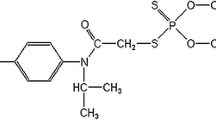Abstract
In vitro studies of IAA-induced cell elongation in Triticum aestivum have demonstrated that lead causes a large reduction in elongation. Inhibition of elongation can be reduced by increasing the concentration of IAA, or by the addition of calcium. The inhibitory effect appears to be linked with changes in the properties of the cell walls. Experiments are described which show that lead becomes bound strongly to certain chemical substances involved in cell wall architecture.
Similar content being viewed by others
References
Albersheim, P.: The walls of growing plant cells. Sci. Amer. 1320, 80–95 (1975)
Barratt, A.J., Northcote, D.H.: Apple fruit pectic substances. Biochem. J. 94, 617–627 (1965)
Bennet-Clark, T.A.: Salt accumulation and mode of action of auxin. A preliminary hypothesis. In: The chemistry and mode of action of plant growth substances, pp. 284–291, Wain, R.L., Wightman, F. eds., London: Butterworths 1956
Berry, R.A.: The manurial properties of lead nitrate. J. Agric. Sci. 14, 58–65 (1924)
Bonnet, E.: Action des sels solubles de plomb sur les plantes. C. R. Acad. Sci. 174, 488–491 (1922)
Burström, H.: The influence of heteroauxin on cell growth and root development. Lantbrukshögskolans Annaler 10, 209–240 (1942)
Burström, H.: Growth and water absorption of Helianthus tuber tissue. Physiol. Plant. 6, 685–691 (1953)
Cleland, R.: A separation of auxin-induced cell-wall loosening into its plastic and elastic components. Physiol. Plant. 11, 599–699 (1958)
Cleland, R., Bonner, J.: The residual effect of auxin on the cell wall. Plant Physiol. 31, 350–354 (1956)
Commoner, B., Fogel, S., Muller, W.H.: The mechanism of auxin action. The effect of auxin on water absorption by potato tuber tissue. Amer. J. Bot. 30, 13–28 (1943)
Darvill, A.G., Smith, C.J., Hall, M.A.: Auxin induced proton release cell wall structure and elongation growth; a hypothesis. In: Regulation of cell membrane activities in plants pp. 275–281, Marre, E., Cifferi, O. eds., Amsterdam: Elsevier 1977
Groenewegen, H., Mills, J.A.: Uptake of mannitol into the shoots of intact barley plants. Aust. J. Biol. Sci. 13, 1–5 (1960)
Hackett, D.P., Thimann, K.V.: The nature of auxin-induced water uptake by potato tissue. Amer. J. Bot. 39, 553–560 (1952)
Hammett, F.S.: The location of lead by growing roots. Proto-plasma 4, 183–185 (1928a)
Hammett, F.S.: The influence of lead on mitosis and cell size in the growing root. Protoplasma 5, 535–542 (1928b)
Heyn, A.N.J.: Der Mechanismus der Zellstreckung. Rec. Trav. Bot. Neerland 28, 113–144 (1931)
John, M.K.: Varietal response to lead by lettuce. Water, Air, Soil Pollution 8, 2, 133–144 (1977)
Keaton, C.M.: The influence of lead compounds on the growth of barley. Soil Sci. 43, 401–411 (1937)
Keegstra, K., Talmadge, K.W., Bauer, W.D., Albersheim, P.: The structure of plant cell walls. III A model of the walls of suspension-cultured sycamore cells based on the interconnections of the macromolecular components. Plant Physiol. 51, 188–196 (1973)
Kertesz, Z.I.: The pectic substances pp. 572–573, London: Inter-science 1951
Lane, S.D., Martin, E.S.: A histochemical investigation of lead uptake in Raphanus sativus. New Phytologist 79, 2. (1977)
Levan, A.: Cytological Reactions induced by inorganic salt solutions. Nature 156, 751–752 (1945)
Masuda, Y.: Auxin-induced growth of tuber tissue of Jerusalem artichoke 1. Cell physiological studies in the expansion growth. Bot. Mag. Tokyo 78, 417–423 (1965)
Mukherji, S., Maitra, P.: Growth and metabolism of germinating rice (Oryza sativa L.) seeds as influenced by toxic concentrations of lead. Z. Pflanzenphysiol. 81, 26–33 (1977)
Mühlethaler, K.: Ultrastructure and formation of plant cell walls. Ann. Rev. Plant Physiol. 18, 1–24 (1967)
Ordin, L., Applewhite, T.H., Bonner, J.: Auxin-induced water uptake by Avena coleoptile sections. Plant Physiol. 31, 44–53 (1956)
Penny, D.: On the possible role of hydrogen ions in auxin-induced growth. In: Regulation of cell membrane activities in plants. pp. 283–290 Marre, E., Cifferi, O. eds. Amsterdam: Elsevier 1977
Pohl, R.: Zur Reaktionsweise des Wuchsstoffes bei der Zellstreckung. Z. Bot. 41, 343 (1953)
Preston, R.D.: The physical biology of plant cell walls. London: Chapman and Hall 1974
Rasmussen, G., Henry, W.: Effect of lead on the growth of sweet orange seedlings in nutrient culture solution. Proc. Soil Crop Sci. Soc. (Florida) 23, 70–74 (1963)
Siegel, S.M.: The plant cell wall. London: Pergamon 1962
Stoklasa, J.: De l'influence de l'uranium et du plomb sur la vegetation. C. R. Acad. Sci. 156, 153–155 (1913)
Strogonov, B.P., Lapina, L.P.: A possible method for studying separately the toxic and osmotic action of salts. Fiziol. Rast. 11, 674–680 (1964)
Stutzer, A.: Die Wirkung von Blei als Reizstoff für Planzen. J. Landwirtschaft 64, 1–8 (1916)
Taylor, S.A.: Measuring soil-water potential. In: Methology of plant eco-physiology (Arid Zone Res. 25). 149–157. Eckardt, F.E. ed. UNESCO, Paris 1965
Zegers, P.V., Harmet, K.H., Hanzely, L.: Inhibition of IAA-induced elongation in Avena coleoptile segments by lead; a physiological and an electron microscopic study. Cytobios. 15, 23–25 (1976)
Author information
Authors and Affiliations
Rights and permissions
About this article
Cite this article
Lane, S.D., Martin, E.S. & Garrod, J.F. Lead toxicity effects on indole-3-ylacetic acid-induced cell elongation. Planta 144, 79–84 (1978). https://doi.org/10.1007/BF00385010
Received:
Accepted:
Issue Date:
DOI: https://doi.org/10.1007/BF00385010




